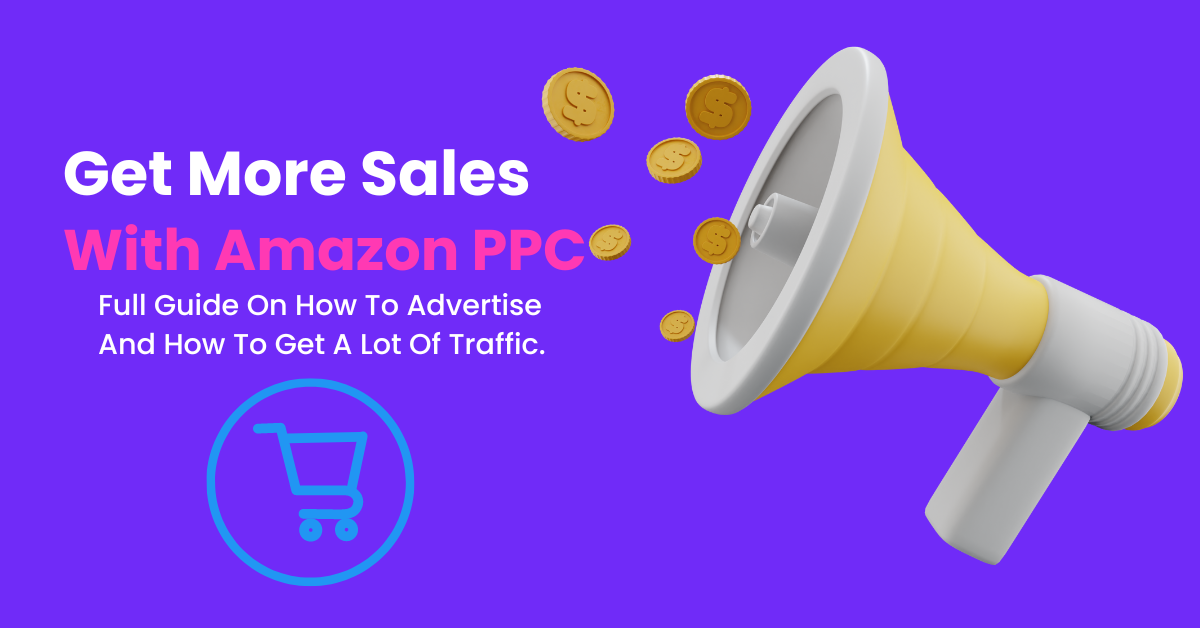In the busy world of online selling, how do you ensure that people pay attention to your product? Amazon PPC strategies is the answer. This helps your product stand out and attract customers who want to buy. Today we’ll talk about how Amazon PPC works and how it can help your business grow. Let’s learn the basics of Amazon PPC and see how it can boost your sales and make your brand more popular.
Advertising revenue of Amazon worldwide from 2019 to 2023
(in billion U.S. dollars)

You can verify this statics data : https://www.statista.com/statistics
Table of Contents
Amazon PPC Strategies: How Does it Work?
Imagine you’re a seller on Amazon. You want more people to buy your awesome products. So, you create ads for those products. When someone searches for something related to your product, your ad might show up. If they click on your ad and check out your product, you pay a small fee to Amazon for bringing that customer to your product page.
Key Terms:
- Keywords: These are the words or phrases that people type into the Amazon search bar when looking for something to buy. For example, if someone is looking for a new pair of sneakers, they might type in “black running shoes” or “women’s athletic shoes.” These words are your tickets to getting your ad in front of potential buyers.
- Bids: Think of bids as the amount of money you’re willing to spend for someone to click on your ad. The higher your bid, the more likely your ad will be shown to shoppers. But remember, you only pay when someone actually clicks on your ad.
- Ad Placements: These are the spots on Amazon where your ads can appear. They could be at the top of search results, on product detail pages, or even on other sellers’ product pages. Where your ad shows up depends on your bid, relevance to the shopper’s search, and other factors.
Example:
Let’s say you sell eco-friendly water bottles on Amazon. You create an ad campaign for your water bottles and choose keywords like “reusable water bottle” and “eco-friendly drinkware.” You set a bid of $0.50 per click.
Now, when someone searches for “green water bottle” on Amazon, your ad might pop up in the search results. If they click on your ad and check out your water bottles, you pay $0.50 to Amazon. If they don’t click, you don’t pay anything.
Why is Amazon PPC important for Amazon sellers
In a highly competitive landscape like Amazon, PPC campaigns are a game changer. In this way:
- Increased product visibility: PPC puts your products in front of a highly targeted audience that is actively searching for similar products, greatly increasing discoverability.
- It Improves Traffic on amazon: Strategic ad placement attracts qualified customers with a genuine interest in your offering, potentially increasing organic traffic as well.
- Better Conversion Rates of a customer : Targeting the right audience with relevant keywords increases the chances of converting clicks into sales.
- Brand Awareness: Repeated exposure through PPC advertising increases brand recognition and increases customer loyalty.
- Data-driven insights: PPC campaigns provide valuable data on customer behavior and keyword performance, allowing you to continually refine your strategy for optimal results.
Crafting an Effective Amazon PPC Strategy
Common Goals for Amazon PPC Campaigns:
Setting clear goals before diving into Amazon PPC campaigns is essential for success. Here’s why this is so important and some common goals sellers often aim for.
- Increase Sales: One of the primary goals for most of the sellers is to increase sales through Amazon PPC campaigns. You can set goals to increase overall sales revenue or focus on specific products or product categories.
- Increase traffic: The second goal is to drive more traffic to your product listings on Amazon. This can help to increase brand awareness and leads generation.
- Improve Product Visibility: Better product visibility is necessary to attract potential customers. You can set goals to improve your product’s visibility in Amazon search results and increase its chances of being discovered by buyers.
- Building Brand Awareness: Building brand awareness is essential for long-term success on Amazon. You can use Best AI Marketing Tools PPC campaigns to introduce your brand to new audiences, establish credibility, and foster brand loyalty among existing customers.
- Maximizing ROI : Getting a positive return on investment is a common goal of Amazon PPC campaigns. You can set goals to maximize your ROI by optimizing your campaigns to generate more revenue while minimizing the advertising costs.
- New Product Launches: When you launch new products on Amazon, your goal may be to generate initial sales and build momentum for the product’s success. Amazon PPC campaigns can help increase visibility and sales for new product launches.
Target audience research:
who is your target customer? What type of keywords they most likely to use ? To get practical information, use the keyword research tool available on Amazon Seller Central.
Keyword Selection:
Choose a mix of short tail and long-tail keywords with relevant search volume and low competition. Use negative keywords to exclude irrelevant searches and avoid wasted spending.
Budgeting:
Set an appropriate budget for your Ads campaign, considering your goals and product margins. Similar budget examples are provided by Amazon PPC, so you can make adjustments as needed.
Types of Amazon PPC ads
79% of Amazon SMB sellers advertise their products on or off Amazon. Of those
- 77% use Sponsored Products ads
- 39% use Sponsored Brands ads
- 30% use Sponsored Display ads.
1. Sponsored Products ads

Sponsored Products ads are shown in search results and product listing pages. This is the most common type of Amazon PPC ad, used by 66% of third-party sellers.
An advertiser has two options for keyword targeting strategies when creating Sponsored Products ads: both automatic and manual targeting Key words.
Automatic targeting
The automatic technique is targeting keywords that Amazon’s algorithm believes are relevant to your product listing. Amazon uses the data it obtains from buyers’ clicks and purchases to tailor the adverts to your listing and enhance conversions.
Sellers are able to use four different keyword match kinds inside automatic targeting:
- Close match advertisements: When customers search for terms that are strongly linked to the product you are promoting, close match advertisements appear.
- Loose match ads: When customers search for terms that are loosely related to your product, loose match ads appear.
- Alternatives: Draw attention to customers who are thinking about purchasing comparable goods under a different brand, such as a Cuisinart blender rather than a KitchenAid blender.
- Complements: Target customers looking at product detail pages that go well with yours (like paintbrushes to match a paint kit).
Manual Targeting
You have to decide the keywords you wish to place a bid on. Ads that are manually targeted are going to show up if a customer’s search terms match with the keywords you have selected. Being a more “hands-on” kind of advertisement, you will occasionally need to keep an eye on cost fluctuations and make necessary modifications. Lower long-term ad spend and more effective advertising are frequently the outcomes of this optimization.
2. Brands that are Sponsored
Sponsored Brands ads give retailers the opportunity to promote many products simultaneously and draw customers in with more visually striking content than Sponsored Products.

Sellers who use Sponsored Brands have a choice of three formats to choose from. These formats can show up as videos or headline banners at the top of Amazon search results.
3. Display advertising that are sponsored
Sellers can retarget customers who have visited their product detail pages on and off Amazon by using Sponsored Display advertising. Sponsored Display advertisements can be found on Amazon’s associate websites, such as Google, Facebook, Netflix, and mobile apps, in contrast to Sponsored Products and Sponsored Brands ads. To use them, a seller needs to have a registered brand, much like with Sponsored Brands ads.
Outside of Amazon Sponsored Brands:

What is the difference between Amazon PPC Ads and Google Ads?
Amazon PPC:
It is designed to promote products directly on Amazon. Ads appear in search results and product detail pages, specifically targeting people who are actively looking for things to buy on Amazon
Google Ads
It provides a large reach across the Google search engine, with ads appearing on search engine results pages (SERPs), websites, and apps in the Google Display Network. It addresses customers at all stages of the buying process, from those who recognize a need to those who are actively examining products.
Conclusion
In short, Amazon PPC strategy is a game changer for generating sales and expanding your brand’s reach on the platform. By strategically setting goals, researching their target audience, and choosing the right keywords and ad types, marketers can maximize their ad investment. Whether you want to increase sales, improve product visibility, or increase brand awareness,
Amazon PPC offers a variety of tools and features to meet your various marketing goals. Use Amazon PPC today to propel your business to success in the competitive e-commerce marketplace. In a business environment. Start optimizing your Amazon PPC strategy now to realize its full potential and accelerate your business growth.



